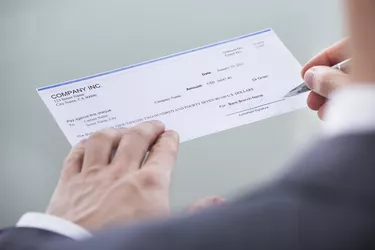
FBO stands for "for benefit of." It is used to endorse a check when an institution or another party, such as a brokerage, fiduciary or trustee, acts on behalf of the primary payee. FBO is also used in connection with electronic payments. Using FBO on a check conveys and protects the ownership of the funds.
When FBO Is Used on a Check
Video of the Day
When used on a check, FBO refers to a payee other than the one whose name appears first on the payee line on the front of the check. On the line next to "Pay to the order of," an FBO check might read: "Jane Smith FBO John Smith." In this case, the funds are intended for John Smith and Jane Smith is allowed to cash or deposit the check on John's behalf.
Video of the Day
Payers use FBO when a third party is conducting a transaction on behalf of the individual who is intended to receive the funds. Situations may include:
- Parents or guardians making a check deposit for a minor
- The transfer of retirement account funds
- The deposit of a rollover check into another retirement plan
- Electronic transfers received and transferred by a financial institution on behalf of an account holder
In each of these situations, money is transferred on an individual's behalf but goes through a third party. In the case of retirement account funds, an FBO rollover check allows an account holder to avoid unnecessary taxation.
For instance, if someone wants to close an old 401(k) and move the funds to an individual retirement arrangement managed by Fidelity, they can have the old management firm send the funds to Fidelity in an FBO check. In most cases, the IRS doesn't tax a rollover transaction because the money never touched the individual's bank account.
How to Endorse a Check Using FBO
When the front of the check contains two names on the payee line, with FBO in the middle, the bank will often require both named individuals to endorse it. On the back of the check, where it says "Endorse check here," both people will sign.
Sometimes, FBO will appear on the check's memo line rather than on the payee line. In that case, the third party may be the only one named on the payee line and the only one who must sign in the endorsement area. If you receive an FBO check, check in with your bank to learn their policy on endorsement.
FBO and Managing Someone Else's Money
FBO is also used when the payee is someone who needs assistance handling financial matters. This can apply to individuals of any age, from a minor named in a living trust to an adult with a fiduciary or financial caregiver acting on their behalf to manage personal finances.
When someone cannot manage distributions of funds on their own or has chosen not to, FBO checks help to protect a payee while someone else handles the transactions.
FBO is just one special endorsement that helps to convey an individual's intentions for a check. Other endorsements help clarify check deposits made into a checking account or savings account.
Different Types of Endorsements
Print "For deposit only" above your signature. Add the account number of the account the funds are going into. | |
Print "For mobile deposit only" above your signature. Add the account number of the account the mobile check is being deposited into | |
Print the business's name exactly as it appears on the Payee line. An authorized person must sign the business check in the endorsement area. | |
Restrictive endorsement | An endorsement that limits the action that can be applied to that check, e.g., for deposit only. |
Blank endorsement | If there is no designated payee, anyone who possesses it can endorse the check and demand payment. If a payee is named, the check must be endorsed. |
If a check is made out to two payees, most banks will require the endorsement of both payees. |